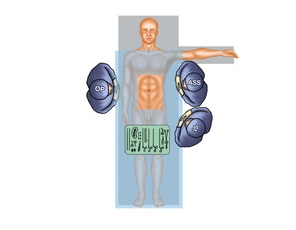The reconstruction of the abdominal wall in complex incisional hernias or the presence of a laparostoma presents a particular challenge. A "loss of domain" represents the extreme form of a volume displacement of the intestines.
Complex hernias are considered to be abdominal wall hernias with defect widths of more than 10 cm, recurrent incisional hernias after mesh implantation (mesh edge herniation, mesh tear, mesh rupture), hernias after flap transfer (denervation, donor site defects), and multiple recurrences.
The abdominal wall defect after laparostoma represents a special situation. An abdominal wall closure has never occurred here. Complicating matters, there is no natural skin in the area of the abdominal wall defect, but rather a split-thickness skin graft. There is also no hernial sac helpful for reconstruction. The closure of the skin can pose an additional problem.
In principle, the indication for repair of even a complex hernia is given. Patients lack ventrally stabilizing elements of the trunk musculature. Patients with such unstable abdominal walls complain of postural problems with back pain. Physically demanding activities and sports are severely restricted to impossible. An intact ventral abdominal wall is of great importance for physiological processes such as breathing and defecation.
Furthermore, the abdominal wall defect and the extra-abdominal organ volume will continue to increase. The reconstruction of the abdominal wall is ultimately performed to prevent increasing morbidity.
To achieve a fascial closure in the midline for these hernias, an abdominal wall component separation is usually required.
With the anterior component separation ("Ramirez") presented here, midline defects with a width of up to 20 cm periumbilically, up to 8 cm epigastrically, and up to 6 cm suprapubically can be closed by separating parts of the lateral abdominal wall. The technique allows for a tension-free closure with a dynamically competent abdominal wall.
Due to the broad detachment of the subcutaneous tissue with the risk of destroying perforating vessels (blood supply to subcutaneous tissue and skin through the deep epigastric vessels) and the consequently high rate of wound healing disorders, hematomas, and seromas, this technique is now considered only as a second-choice procedure. The posterior component separation, which leads to a release in the area of the transversus muscle, is favored; additionally, the mesh bed can be extended laterally, dorsally, and retrocostally.
The reconstruction according to Ramirez was described in the original work without mesh augmentation. The results in the literature favor the simultaneous implantation of a retromuscular mesh.
In the demonstrated case, after small bowel perforation and peritonitis, a monstrous abdominal wall defect of 20 cm width occurred. The defect extends from subxiphoidal to the symphysis and is closed by an abdominal wall plasty using component separation and subfascial mesh augmentation.



